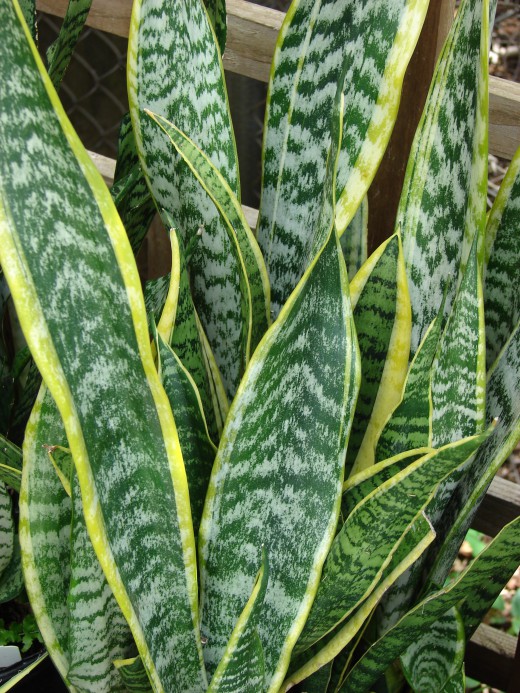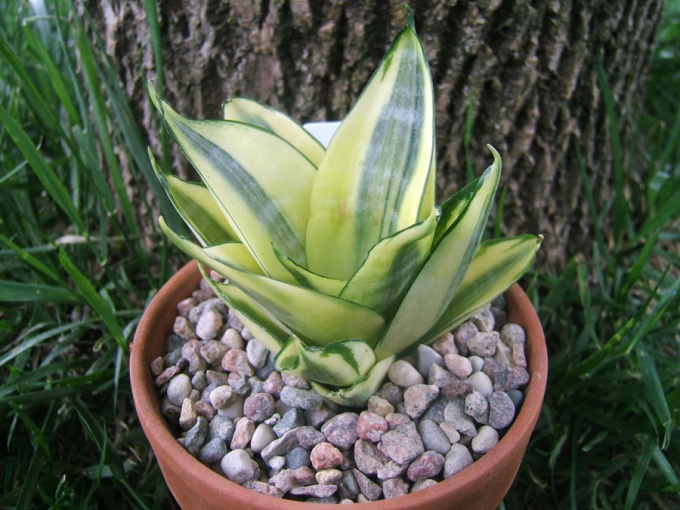In the people this plant is called "Teschin language" and "pike's tail". This plant is known in Europe since the 18th century: in Britain this plant is called "devil's tongue", "leopard Lily", "snake skin", while in Germany - "African hemp".
There is a sign that sansevieriya provoke people on all sorts of gossip, rumors, but according to Chinese teachings sansevieriya able to absorb the negative thoughts and banish evil energy and bad intentions. The flower contributes to the inspiration and development of the enterprise and can prevent headaches and colds.
The types sansevieriya
1. Sansevieriya cylindrical has dark green leathery leaves with stripes that go from the rosette, and the border yellow.
2. Sansevieriya Hanni, distinct from all other varieties in small sizes, reaches a height of about 30 cm and has short green leaves in the shape of a rosette.
3. Sansevieriya three-banded, grow to a height of 100 cm, has elongated upright leaves with transverse stripes. This plant feels great in the shade and Sunny location.

Transplant sansevieriya
To repot this plant until its roots are fully grown and covered the whole earth contained in the pot. Do this about 1 time in 3 years. To do this, choose only thick-walled pot, for example, from clay. In any case, do not take too large a pot — plant, it will be uncomfortable.
The ground for sansevieriya
Connect in the proportions 2:1:1:1:1 turf, leaf soil, humus, sand and peat. On the bottom of the pot put expanded clay drainage.
The plant does not require frequent feeding, however, in warm season you can use a fertilizer suitable for other succulents, and to feed the plants 1 time per month. Fertilizer should not contain large amount of nitrogen, otherwise it may lead to rotting roots. The excess fertilizer may also spoil the appearance of a sansevieriya.
Watering and lighting sansevieriya
Because sansevieriya — it's a succulent, water it should not be often, as the plant accumulates nutrients in its leaves. In the warm season flower watering only when the soil gets dry, about 1 time a week. In the cool time of the year need to be watered more frequently. For watering, use rain, distilled or melted water.
The plant can be placed both in the sun and in the shade, but the flower prefers well-lit place. The lack of sun can lead to stunted growth, also the leaves are not so brightly colored.
Temperature for sansevieriya
The optimum temperature is not below 15 degrees. Sansevieriya well tolerated heat. In the cold season do not lean the flower against the cold glass, as this can lead to hypothermia, and the plant will die.
Reproduction sansevieriya
1. Seeds. This plant can be propagated by seeds. In plastic cups with fertile soil you plant the seeds, keep them in the greenhouse at an elevated temperature.
2. Propagation by division. Remove the plants from the soil, then rinse the roots, separate the part of the rhizome with the leaves and plant it in fertile soil. This is best done in early spring.
3. Reproduction by cuttings. Cut the sheet of 7 cm, wait a few days for drying of the sheet, and then transplant it important in sandy soil to a depth of 2 cm Rooting may occur within 2 months, the Rooted plant will transplant into a pot with fertile soil.
Diseases and pests sansevieriya
Pale-yellow leaves will tell you that sansevieriya affected spider mites. It is necessary to spray with insecticide. Thrips can hit shoots, use the same drugs.
If the leaves become bent out of shape and die, the cause of the lesion may become mealybug. Treat the plant with a damp sponge, and then with Malathion.
If the leaves become yellow or white, then maybe the plant is too hot and too bright sun. The cause of the rot may be a surplus of moisture. In any case, the affected leaves should be cut.
